Introduction to Social Media Marketing
Social Media Marketing is the process of leveraging a brand’s presence and content across social media platforms in order to increase its visibility and reach. Every day, millions of people are logged onto platforms such as Twitter, Instagram, and Facebook, providing businesses with a tremendous opportunity to tap into this market. With the right strategies and tactics, businesses can build and optimize their brand on social media in order to maximize their exposure and gain more customers.
Using social media to promote a brand is much more cost effective than traditional methods such as print advertising and radio commercials. Additionally, it is easier to measure the results of a social media campaign and thereby adjust it accordingly. Furthermore, social media gives a business the ability to interact with its customers and build a relationship with them. This is why social media marketing has become increasingly important for brands wanting to stay competitive in today’s ever-evolving market.
Education/Basics
Social Media Marketing (SMM) is the process of utilizing various social media platforms to promote your brand, products and services. It helps business owners reach out to a wide range of potential customers, and generate brand awareness.
There are several social media platforms available today, each of them designed with different features and user demographics. They include Facebook, Twitter, Instagram, Snapchat, YouTube, LinkedIn, Pinterest, etc. Each platform’s features and user demographics vary from one another and offer different approaches to reach the desired goals.
Facebook, for example, is used for engaging visuals and content, while Twitter is better for short-form messages and industry updates. Instagram is best for beautiful photography and storytelling, while YouTube and SnapChat are excellent for video content. LinkedIn is great for professional connections, while Pinterest is excellent for creative visuals.
These different social media platforms can be used for different purposes. For example, businesses can use them to reach out to potential customers, current customers, employees, partners, and investors. They can also use them to share news, updates, special offers, promotions, and other content related to their brand.
The key thing to remember is that all social media platforms need to be used in an effective manner to reach the desired goals. It is essential to understand the purpose of each platform, how it works, and what kind of content will be most resonant with its user base.
Analyzing the Market
Social media platforms offer valuable data and analytics that can be used to understand your target audience. This includes information such as gender, age, location, interests and hobbies. This allows you to create campaigns tailored specifically for your target market, helping to ensure higher engagement and brand reach.
Using data and analytics also helps you to identify areas of improvement for your brand. For example, if you notice a low engagement rate on certain platforms, it could be down to the content or the platform itself. You can also use data to compare with other competitors in the market, helping you to see where you stand in terms of performance and reach.
Understanding the habits of your audience is key when it comes to social media marketing. Knowing when they are online and what type of content they are engaging with helps to inform your strategies. You can also use this data to determine which platforms are the most effective for reaching your specific target market.
Using data and analytics to gain an understanding of your target audience is essential when it comes to social media marketing. Utilizing the data available to you will help you to create campaigns that are tailored to your specific audience, allowing you to improve your reach, engagement and performance.
Goals & Strategies
Social media marketing is all about setting goals and developing strategies that are tailored to reaching them. When it comes to your brand’s social media marketing plan, you must discover what you want to achieve with each platform and create strategies that are designed specifically to help you reach those goals.
Your goals should be tailored to your brand and your industry. For example, if you operate within the e-commerce space, you may have the goal of driving sales through your social media presence. Alternatively, if you work in the hospitality industry, you may be more focused on building relationships and engaging with potential customers.
Whatever your specific goals may be, it is important to determine them and develop comprehensive strategies for each platform.
When creating a strategy, it is also important to consider your target audience and establish what kind of content will resonate with them. Understanding their preferences and interests will help inform your content plan and provide you with a better sense of how your content should be delivered. Additionally, it’s essential to consistently analyze the data and metrics associated with each platform to gain an understanding of what is or isn’t working. This information can be used to refine your strategy and ensure that you are making the most of your efforts.
Developing a customized strategy for each platform is key to a successful social media marketing plan. It is essential to have a clear understanding of your goals and use data and analytics to guide your decisions in order to get the best results.
Tactics and Tools to Reach the Audience Across Social Platforms
When it comes to successfully marketing a brand through social media, it’s important to be aware of various tactics and tools which can help in reaching a unique type of audience. Some tools that can help are social media management tools, influencer marketing, content scheduling, and more.
Social Media Management Tools – These are tools designed to help you manage multiple social channels in one place. This saves time and makes it easy to connect with your customers, create campaigns, and monitor results. Examples of these tools include Hootsuite, Sprout Social, and Buffer.
Influencer Marketing – This is when you partner with someone who is an expert or has a large following on social media. This can be done with celebrities, bloggers, or other influential people. By partnering with an influencer, you can potentially tap into their network and gain exposure for your brand.
Content Scheduling – This is a tool that helps you plan out and automatically post content at the best times for engagement. Content scheduling tools can help to ensure that your content reaches the right people in a timely manner.
These are just a few examples of tactics and tools that can be used to reach a unique type of audience across multiple platforms. With the right strategy and execution, these tools can help to increase brand reach and visibility.
Implementing the Plan: Executing a Successful Social Media Marketing Strategy
Now that you have a sound understanding of social media platforms, their data and analytics, objectives, strategies and tactics, it’s time to execute. Here are some tips to get you started:
- Define a timeline – Set specific start and end dates for your campaign. Goal setting goes hand in hand with this timeline; break down activities into manageable chunks.
- Get resource support – This is a critical factor in any successful marketing strategy, so make sure you have sufficient personnel and budget to get the job done.
- Create compelling content – Content on social media should be creative, relevant and engaging. Think about how you can create message clusters for your content that communicate your brand’s narrative.
- Optimize campaigns – Constantly review the results of your campaigns, both in terms of reach and engagement, and use this to inform future strategies.
- Utilize automation – Automation software like Hootsuite or Buffer can help significantly reduce the workload associated with social media management which allows teams to focus on content creation and audience engagement.
By following these steps and being mindful of the data gathered and platform specific tactics, you will begin to see an increase in brand awareness and reach on social media.
Measuring & Managing Success
Once your social media marketing plan is in motion, it’s vital to measure success and manage expectations. Setting up objectives and goals is key to measuring success. What do you want to achieve? Are you looking to increase brand awareness or generate more sales? Once your objectives are identified, you can measure progress through KPIs (Key Performance Indicators).
These KPIs may include the number of followers, engagement rates, website visits, conversions, shares, and other metrics. You can use these to compare different campaigns and assess the overall performance of the campaigns.
It is also important to be aware of industry trends and adjust your strategies according to any changes. Consistently monitor performance and adjust your tactics when necessary to ensure maximum impact.
Conclusion
Social media marketing is a powerful tool for creating and growing brand awareness. The key to success lies in understanding your target audience, setting goals for each platform, developing a unique strategy, utilizing the right tactics and tools, and measuring success. In other words, you must be willing to create a customized plan and execute it diligently in order to reach the desired objectives. That being said, it is important to remember that a solid social media strategy takes time and constant monitoring in order to remain successful.
At the end of the day, the goal is to create meaningful connections with the audience while increasing brand visibility on digital platforms. By following the steps discussed in this guide, businesses can establish a strong social media presence with an engaged user base, which can greatly contribute to the overall success of their brand.
comments: 0

